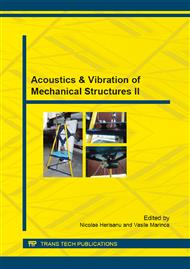[1]
A. Nachemson, Disc pressure measurements, Spine (Phila Pa 1976), 6(1981) 93-100.
Google Scholar
[2]
N.D. Panagiotacopulos, R. Bloch, W.G. Knauss, P. Harvey, M. Patzakis, Viscoelastic behavior of the human intervertebral disc under consideration of moisture migration, US Air Force Office of Scientific Research grant no. 77-3139, California Institute of Technology Pasadena, June 27, (1977).
DOI: 10.21236/ada053036
Google Scholar
[3]
S. Campana, E. Charpail, J.A. de Guise, L. Rillardon, W. Skalli, D. Mitton, Relationships between viscoelastic properties of lumbar intervertebral disc and degeneration grade assessed by MRI, J. Mech. Behav. Biomed. 4(4) (2011) 593-602.
DOI: 10.1016/j.jmbbm.2011.01.007
Google Scholar
[4]
J.M. Peloquin, J.H. Yoder, N.T. Jacobs, E.J. Vresilovic, D.M. Elliott, Degeneration Reduces Human Intervertebral Disc Equilibrium Modulus in Stress Relaxation, Information on: http: /www. ors. org/Transactions/60/1584. pdf, last accessed 06. 05. (2015).
Google Scholar
[5]
A.M. Ellingson, D.J. Nuckley, Intervertebral disc viscoelastic parameters and residual mechanics spatially quantified using a hybrid confined/in situ indentation method, J. of Biomech. 45(3) (2012) 491–496.
DOI: 10.1016/j.jbiomech.2011.11.050
Google Scholar
[6]
K. Ya-Wen, W. Jaw-Lin, Rheology of intervertebral disc: an ex vivo study on the effect of loading history, loading magnitude, fatigue loading, and disc degeneration, Spine 35(16)(2010) 743-752.
DOI: 10.1097/brs.0b013e3181d7a839
Google Scholar
[7]
D. Vogtmann, Stress Relaxation in Poly(methyl methacrylate), Advisor: Dr. Rebecca Dupaix, The Ohio State University 2009, Information on: https: /kb. osu. edu/dspace/bitstream/handle/1811/36980/Dana_Vogtmann_Honors_Thesis. pdf, last accessed 06. 05. (2015).
Google Scholar
[8]
J.N. Jackson, Mechanical properties of the intervertebral disc as an estimator of postmortem interval, 2003, http: /etd. fcla. edu/CF/CFE0000666/Jackson_Jennifer_N_200508_MS. pdf, last accessed 06. 05. (2015).
Google Scholar
[9]
D. Roylance, Engineering Viscoelasticity, Department of Materials Science and Engineering Massachusetts Institute of Technology Cambridge, 2001, http: /ocw. mit. edu/courses/materials-science-and-engineering/3-11-mechanics-of-materials-fall-1999/modules/visco. pdf, last accessed 06. 05. (2015).
Google Scholar
[10]
B. Drouin, D. Mantovani, R.M. Irastorz, Matlab Simulink: an easy-to-use tool to study mechanical response of collagen gels submitted to complex strain excursions, Information on: http: /esbiomech. org/papers/ESB_congress_2013/oral/S39. 4-126. pdf, last accessed 06. 05. (2015).
Google Scholar


